Estimation of Live Load Distribution Factor for a PSC I Girder Bridge in an Ambient Vibration Test
Abstract
:1. Introduction
2. Estimation of Live Load Distribution Factor Using Empirical Mode Decomposition
2.1. Empirical Mode Decomposition
2.2. Estimation of Live Load Distribution Factor
3. Estimation of Live Load Distribution Factor Using the Vehicle Loading Test
3.1. Experimental Setup
3.2. Vehicle Loading Test
4. Estimation of LLDF in the Ambient Vibration Test
5. Conclusions
Author Contributions
Funding
Institutional Review Board Statement
Informed Consent Statement
Data Availability Statement
Conflicts of Interest
References
- Srinivas, V.; Sasmal, S.; Banjara, N.K.; Ramanjaneyulu, K.; Iyer, N.R. Health assessment of a plate girder railway bridge under increased axle loads. J. Bridge Eng. 2013, 18, 969–979. [Google Scholar] [CrossRef]
- Jang, S.; Li, J.; Spencer, B.F. Corrosion estimation of a historic truss bridge using model updating. J. Bridge Eng. 2013, 18, 678–689. [Google Scholar] [CrossRef]
- Bayaraktar, A.; Altunişik, A.C.; Türker, T. Structural health assessment and restoration procedure of an old riveted steel arch bridge. Soil Dyn. Earthq. Eng. 2016, 83, 148–161. [Google Scholar] [CrossRef]
- Furinghetti, M.; Pavese, A.; Lunghi, F.; Silvestri, D. Strategies of Structural Health Monitoring for Bridges based on Cloud Computing. J. Civ. Struct. Health Monit. 2019, 9, 607–616. [Google Scholar] [CrossRef]
- Mehrani, E.; Ayoub, A.; Ayoub, A. Evaluation of fiber optic sensors for remote health monitoring of bridge structures. Mater. Struct./Mater. Constr. 2009, 42, 183–199. [Google Scholar] [CrossRef]
- Liu, M.; Frangopol, D.M.; Kim, S. Bridge safety evaluation based on monitored live load effects. J. Bridge Eng. 2009, 14, 257–269. [Google Scholar] [CrossRef]
- Sanayei, M.; Phelps, J.E.; Sipple, J.D.; Bell, E.S.; Brenner, B.R. Instrumentation, nondestructive testing, and finite-element model updating for bridge evaluation using strain measurements. J. Bridge Eng. 2012, 17, 130–138. [Google Scholar] [CrossRef] [Green Version]
- Kim, S.W.; Jeon, B.G.; Kim, N.S.; Park, J.C. Vision-based monitoring system for evaluating cable tensile forces on a cable-stayed bridge. Struct. Health Monit. 2013, 12, 440–456. [Google Scholar] [CrossRef]
- Kim, S.W.; Jeon, B.G.; Cheung, J.H.; Kim, S.D.; Park, J.B. Stay cable tension estimation using a vision-based monitoring system under various weather conditions. J. Civ. Struct. Health Monit. 2017, 7, 343–357. [Google Scholar] [CrossRef]
- Clemente, P.; Bongiovanni, G.; Buffarini, G.; Saitta, F. Structural health status assessment of a cable-stayed bridge by means of experimental vibration analysis. J. Civ. Struct. Health Monit. 2019, 9, 655–669. [Google Scholar] [CrossRef]
- Vazquez, B.G.E.; Gaxiola-Camacho, J.R.; Bennett, R.; Guzman-Acevedo, G.M.; Gaxiola-Camacho, I.E. Structural evaluation of dynamic and semi-static displacements of the Juarez Bridge using GPS technology. Meas. J. Int. Meas. Confed. 2017, 110, 146–153. [Google Scholar] [CrossRef]
- Atesi, S.; Miri, A.; Jahangiri, M. Assessment of load carrying capacity enhancement of an open spandrel masonry arch bridge by dynamic load testing. Int. J. Archit. Herit. 2017, 11, 1086–1100. [Google Scholar]
- Gocál, J.; Odrobiňák, J. On the influence of corrosion on the load-carrying capacity of old riveted bridges. Materials 2020, 13, 717. [Google Scholar] [CrossRef] [Green Version]
- Wang, X.; Mao, X.; Frangopol, D.M.; Dong, Y.; Wang, H.; Tao, P.; Qi, Z.; Tang, S. Full-scale experimental and numerical investigation on the ductility, plastic redistribution, and redundancy of deteriorated concrete bridges. Eng. Struct. 2021, 234, 111930. [Google Scholar] [CrossRef]
- Olaszek, P.; Łagoda, M.; Casas, J.R. Diagnostic load testing and assessment of existing bridges: Examples of application. Struct. Infrastruct. Eng. 2014, 10, 834–842. [Google Scholar] [CrossRef]
- Dong, C.; Bas, S.; Debees, M.; Alver, N.; Catbas, F.N. Bridge load testing for identifying live load distribution, load rating, serviceability and dynamic response. Front. Built Environ. 2020, 6, 46. [Google Scholar] [CrossRef]
- Sun, Z.; Siringoringo, D.M.; Fujino, Y. Load-carrying capacity evaluation of girder bridge using moving vehicle. Eng. Struct. 2021, 229, 111645. [Google Scholar] [CrossRef]
- Harris, D.K. Assessment of flexural lateral load distribution methodologies for stringer bridges. Eng. Struct. 2010, 32, 3443–3451. [Google Scholar] [CrossRef]
- Seo, J.; Phares, B.; Wipf, T.J. Lateral live-load distribution characteristics of simply supported steel girder bridges loaded with implements of husbandry. J. Bridge Eng. 2014, 19, 04013021. [Google Scholar] [CrossRef]
- Ravazdezh, F.; Seok, S.; Haikal, G.; Ramirez, J.A. Effect of nonstructural elements on lateral load distribution and rating of slab and T-beam bridges. J. Bridge Eng. 2021, 26, 04021063. [Google Scholar] [CrossRef]
- Malveiro, J.; Ribeiro, D.; Sousa, C.; Calçada, R. Model updating of a dynamic model of a composite steel-concrete railway viaduct based on experimental tests. Eng. Struct. 2018, 164, 40–52. [Google Scholar] [CrossRef]
- Ferrari, R.; Froio, D.; Rizzi, E.; Gentile, C.; Chatzi, E.N. Model updating of a historic concrete bridge by sensitivity- and global optimization-based Latin Hypercube Sampling. Eng. Struct. 2019, 179, 139–160. [Google Scholar] [CrossRef]
- Kim, S.W.; Cheung, J.H.; Park, J.B.; Na, S.O. Image-based back analysis for tension estimation of suspension bridge hanger cables. Struct. Control. Health Monit. 2020, 27, e25083. [Google Scholar] [CrossRef]
- Xia, Z.; Li, A.; Li, J.; Shi, H.; Duan, M.; Zhou, G. Model updating of an existing bridge with high-dimensional variables using modified particle swarm optimization and ambient excitation data. Meas. J. Int. Meas. Confed. 2020, 159, 107754. [Google Scholar] [CrossRef]
- Svendsen, B.T.; Petersen, Ø.W.; Frøseth, G.T.; Rønnquist, A. Improved finite element model updating of a full-scale steel bridge using sensitivity analysis. Struct. Infrastruct. Eng. 2021, 1–17, ahead-of-print. [Google Scholar] [CrossRef]
- Jung, D.S.; Kim, C.Y. Finite element model updating on small-scale bridge model using the hybrid genetic algorithm. Struct. Infrastruct. Eng. 2013, 9, 481–495. [Google Scholar] [CrossRef]
- Jung, D.S.; Kim, C.Y. Finite element model updating of a simply supported skewed PSC I-girder bridge using Hybrid Genetic Algorithm. KSCE J. Civ. Eng. 2013, 17, 518–529. [Google Scholar] [CrossRef]
- Aloisio, A.; Alaggio, R.; Fragiacomo, M. Dynamic identification and model updating of full-scale concrete box girders based on the experimental torsional response. Constr. Build. Mater. 2020, 264, 120146. [Google Scholar] [CrossRef]
- Hasançebi, O.; Dumlupinar, T. Linear and nonlinear model updating of reinforced concrete T-beam bridges using artificial neural networks. Comput. Struct. 2013, 119, 1–11. [Google Scholar] [CrossRef]
- Kim, H.J.; Park, W.; Koh, H.M.; Choo, J.F. Identification of structural performance of a steel-box girder bridge using machine learning technique. In Proceedings of the IABSE Workshop on Assessment, Upgrading and Refurbishment of Infrastructures, Rotterdam, The Netherlands, 6–8 May 2013. [Google Scholar]
- Sanayei, M.; Khaloo, A.; Gul, M.; Necati Catbas, F. Automated finite element model updating of a scale bridge model using measured static and modal test data. Eng. Struct. 2015, 102, 66–79. [Google Scholar] [CrossRef]
- Hester, D.; Koo, K.; Xu, Y.; Brownjohn, J.; Bocian, M. Boundary condition focused finite element model updating for bridges. Eng. Struct. 2019, 198, 109514. [Google Scholar] [CrossRef]
- Tarhini, K.M.; Frederick, G.R. Wheel load distribution in I-girder highway bridges. J. Struct. Eng. (US) 1992, 118, 1285–1294. [Google Scholar] [CrossRef]
- Hodson, D.J.; Barr, P.J.; Halling, M.W. Live-load analysis of posttensioned box-girder bridges. J. Bridge Eng. 2012, 17, 644–651. [Google Scholar] [CrossRef]
- Kim, S.W.; Lee, S.S.; Kim, N.S.; Kim, D.J. Numerical model validation for a prestressed concrete girder bridge by using image signals. KSCE J. Civ. Eng. 2013, 17, 509–517. [Google Scholar] [CrossRef]
- Huseynov, F.; Brownjohn, J.M.W.; O’Brien, E.J.; Hester, D. Analysis of load test on composite I-girder bridge. J. Civ. Struct. Health Monit. 2017, 7, 163–173. [Google Scholar] [CrossRef] [Green Version]
- Zhao, Y.; Cao, X.; Zhou, Y.; Wang, G.; Tian, R. Lateral load distribution for hollow slab bridge: Field test investigation. Int. J. Concr. Struct. Mater. 2020, 14, 22. [Google Scholar] [CrossRef]
- Hughs, E.; Idriss, R. Live-load distribution factors for prestressed concrete, spread box-girder bridge. J. Bridge Eng. 2006, 11, 573–581. [Google Scholar] [CrossRef]
- Eom, J.S. Verification of lateral live load distribution factors for continuous steel girder bridges based on diagnostic testing results. Korea Inst. Struct. Maint. Insp. 2009, 13, 180–187. [Google Scholar]
- Harris, D.K.; Gheitasi, A. Implementation of an energy-based stiffened plate formulation for lateral load distribution characteristics of girder-type bridges. Eng. Struct. 2013, 54, 168–179. [Google Scholar] [CrossRef]
- Hernandez, E.S.; Myers, J.J. Load distribution of a prestressed self-consolidating concrete bridge. Front. Built Environ. 2019, 5, 96. [Google Scholar] [CrossRef]
- Choi, W.; Mohseni, I.; Park, J.; Kang, J. Development of live load distribution factor equation for concrete multicell box-girder bridges under vehicle loading. Int. J. Concr. Struct. Mater. 2019, 13, 22. [Google Scholar] [CrossRef]
- Huang, N.E.; Shen, Z.; Long, S.R.; Wu, M.C.; Shih, H.H.; Zheng, Q.; Yen, N.C.; Tung, C.C.; Liu, H.H. The empirical mode decomposition and the Hilbert spectrum for nonlinear and non-stationary time series analysis. Proc. R. Soc. A Math. Phys. Eng. Sci. 1998, 454, 903–995. [Google Scholar] [CrossRef]
- Junsheng, C.; Dejie, Y.; Yu, Y. Research on the intrinsic mode function (IMF) criterion in EMD method. Mech. Syst. Signal Process. 2006, 20, 817–824. [Google Scholar] [CrossRef]
- Chang, S.J.; Kim, N.S. Estimation of displacement response from FBG strain sensors using empirical mode decomposition technique. Exp. Mech. 2012, 52, 573–589. [Google Scholar] [CrossRef]
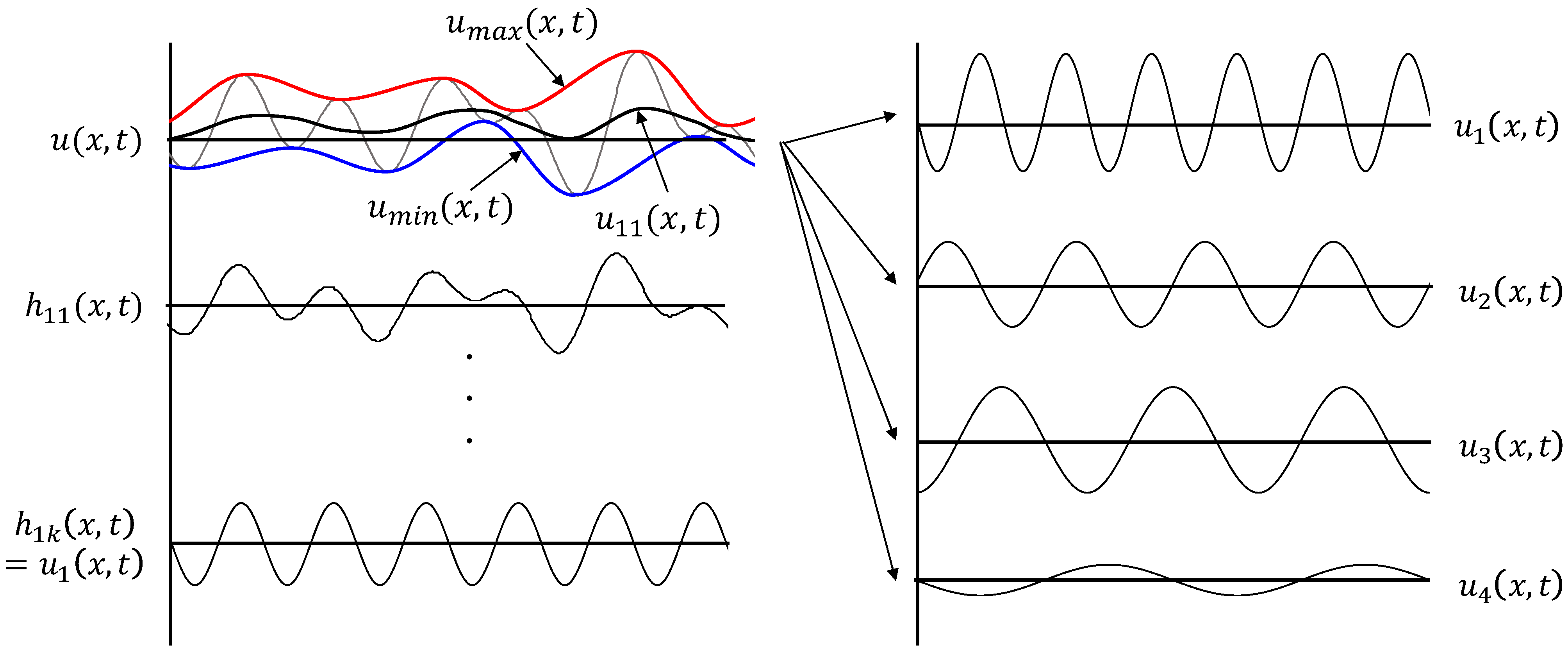
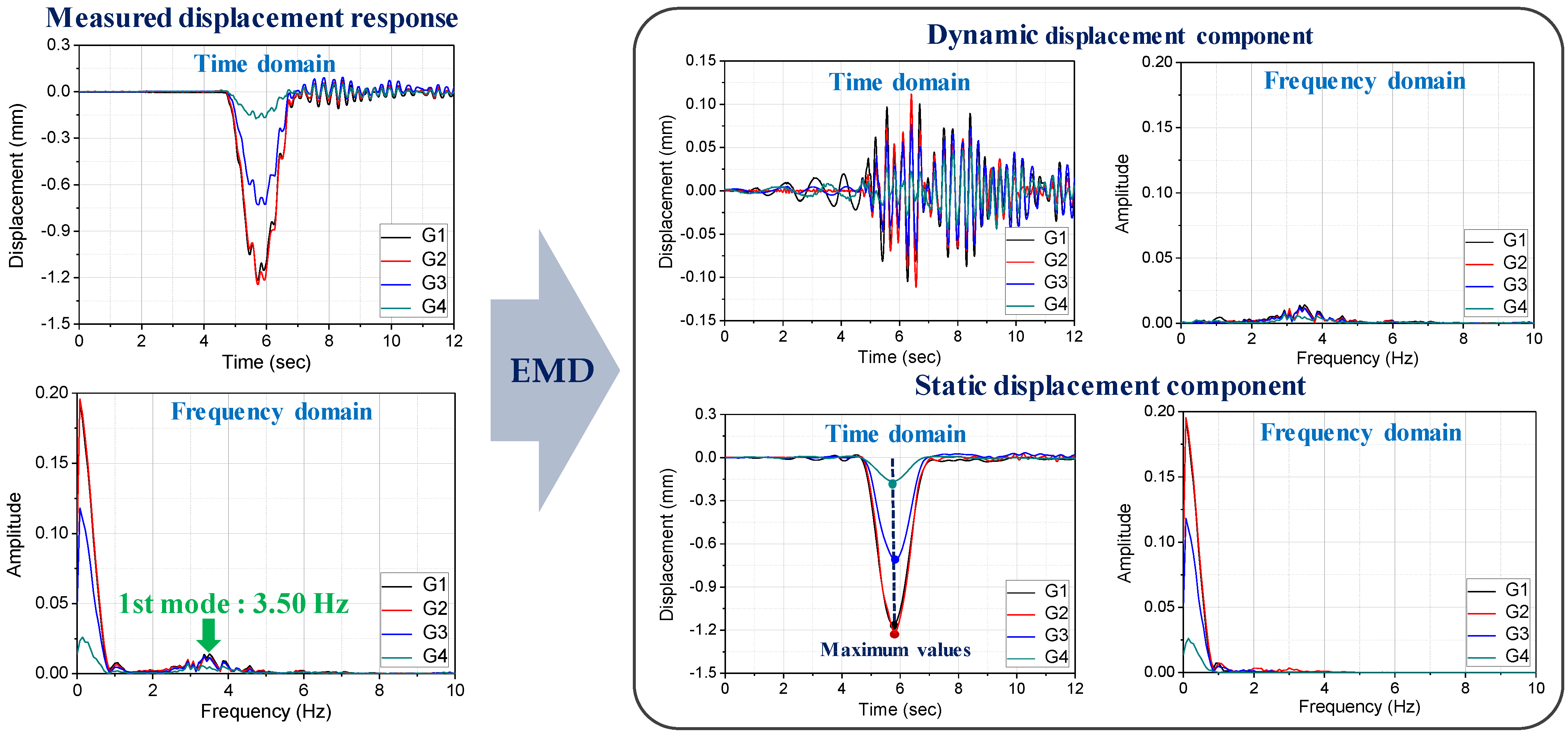

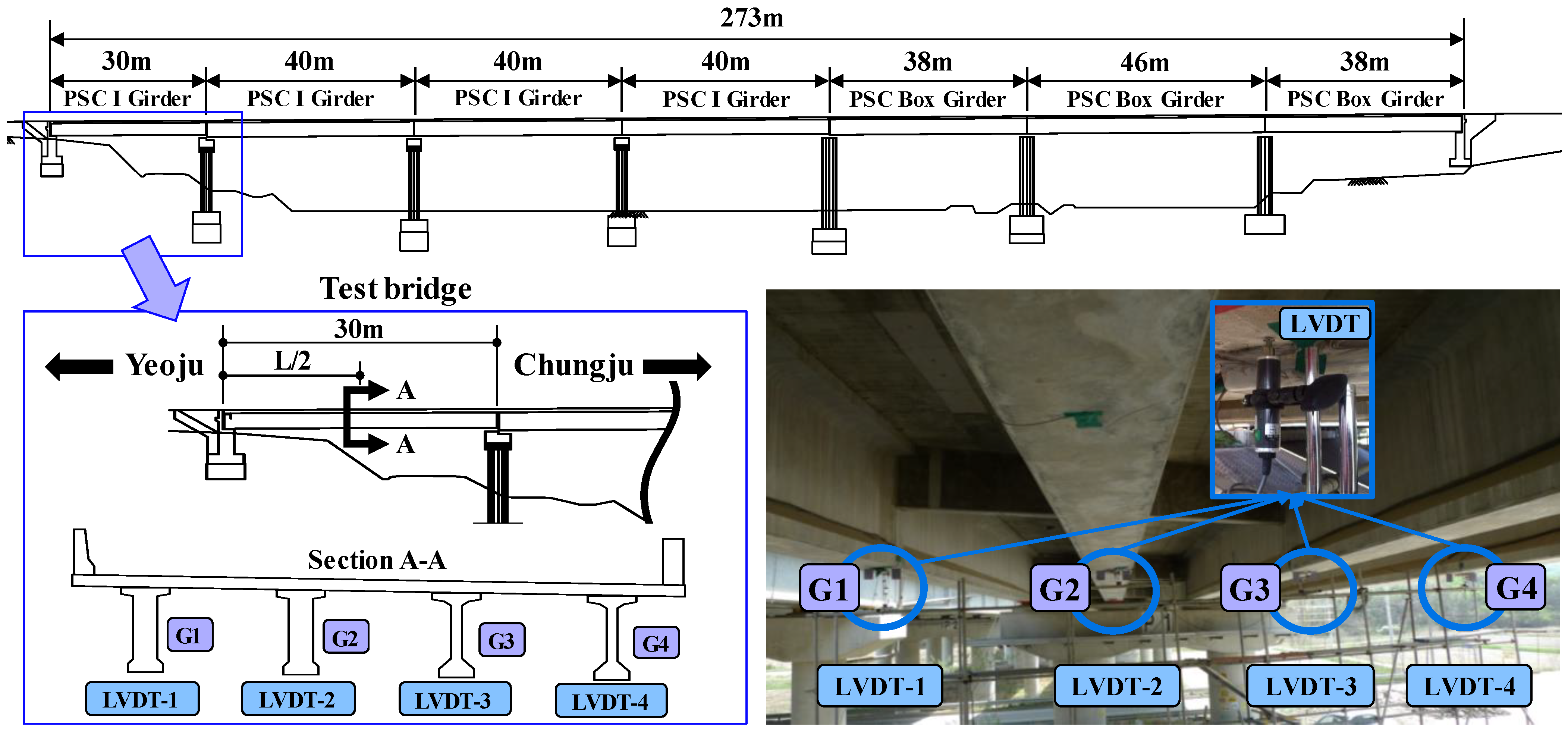


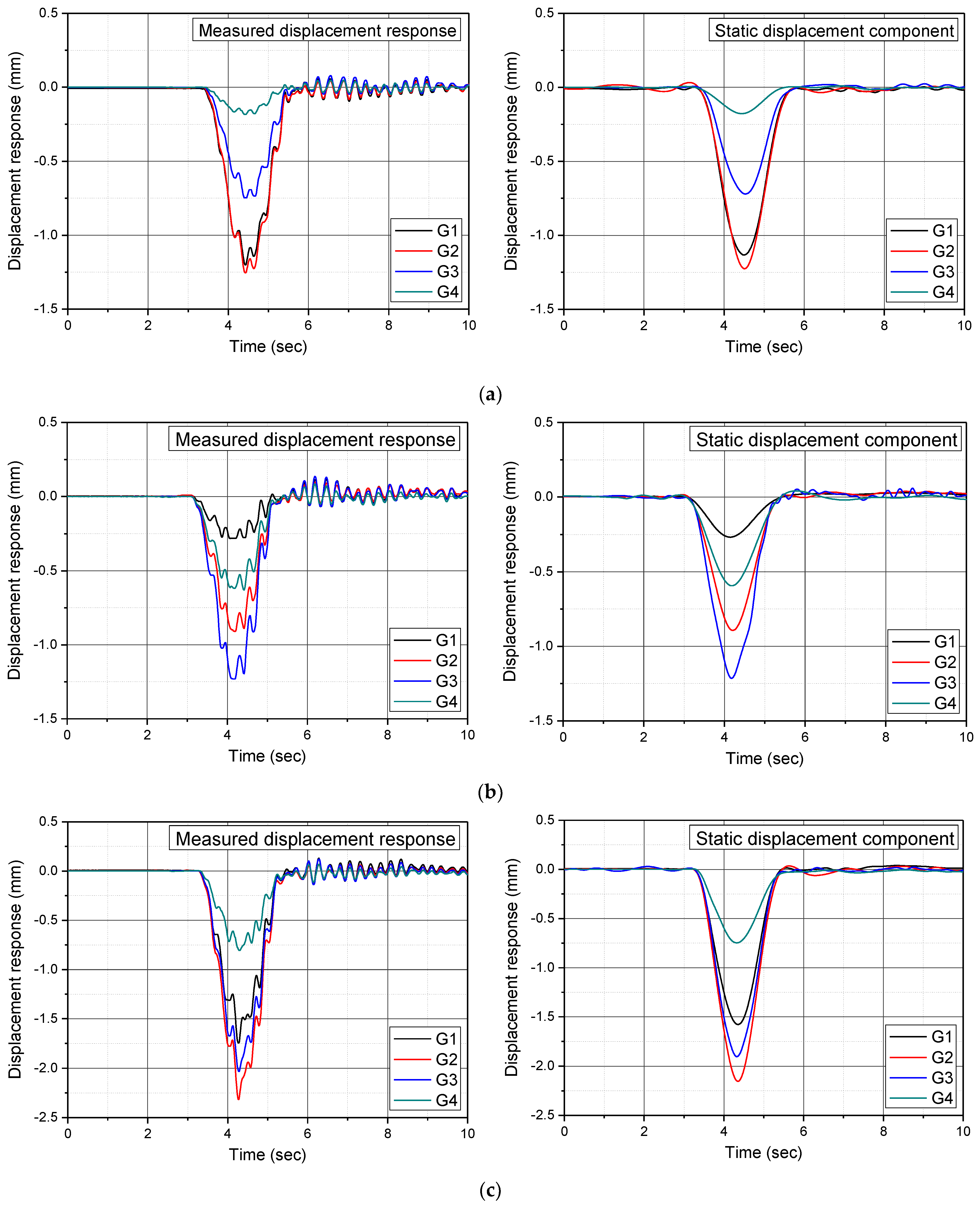
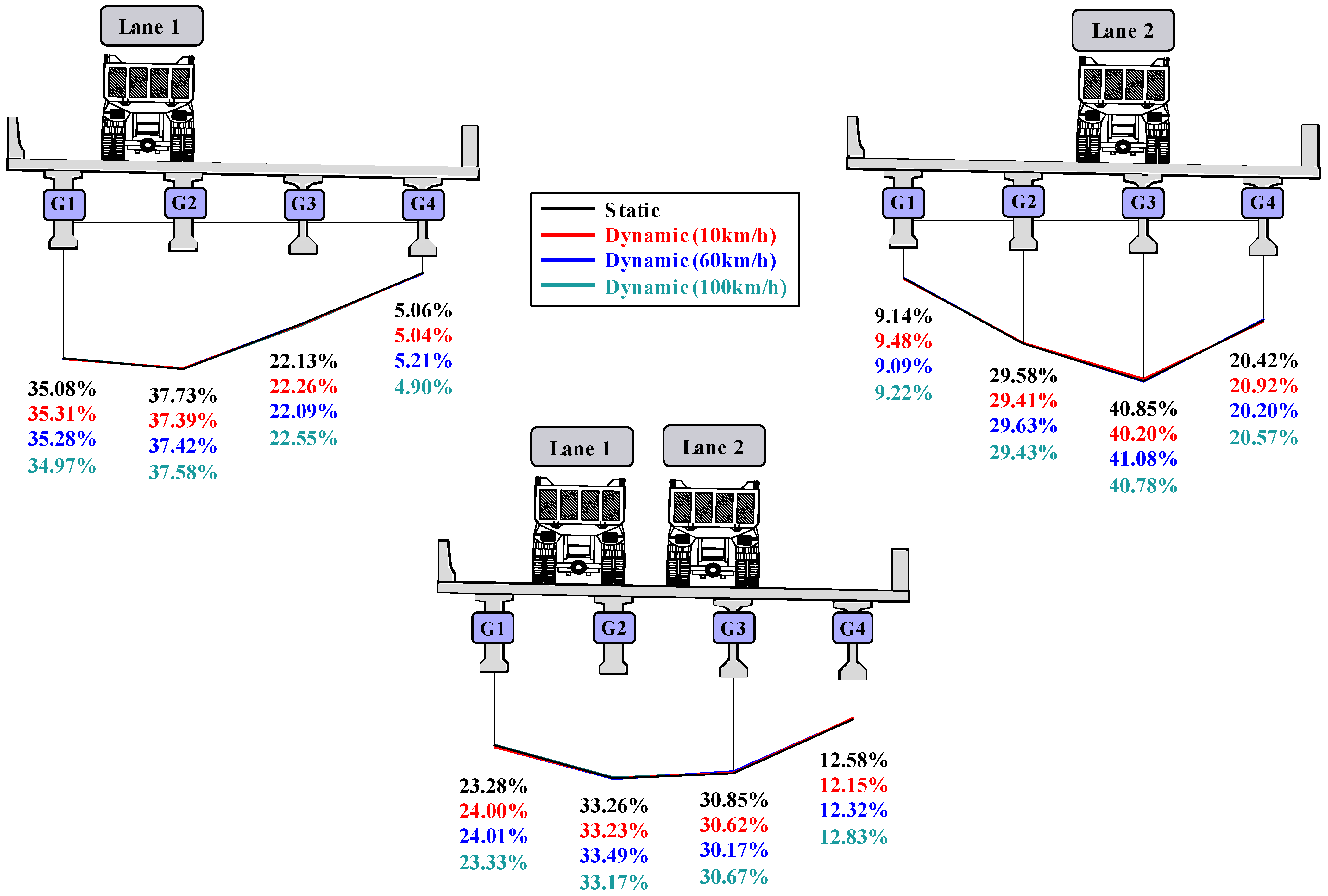
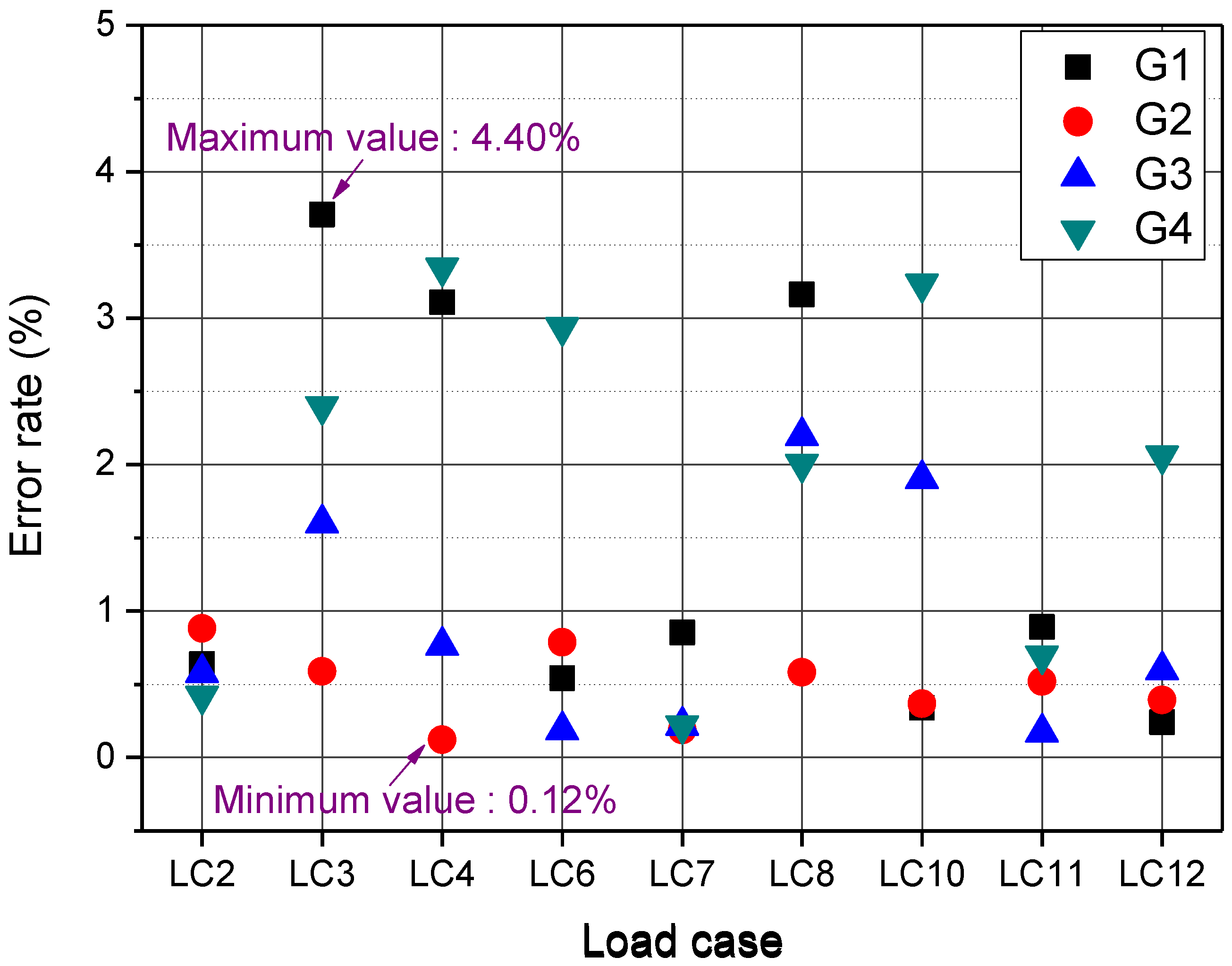

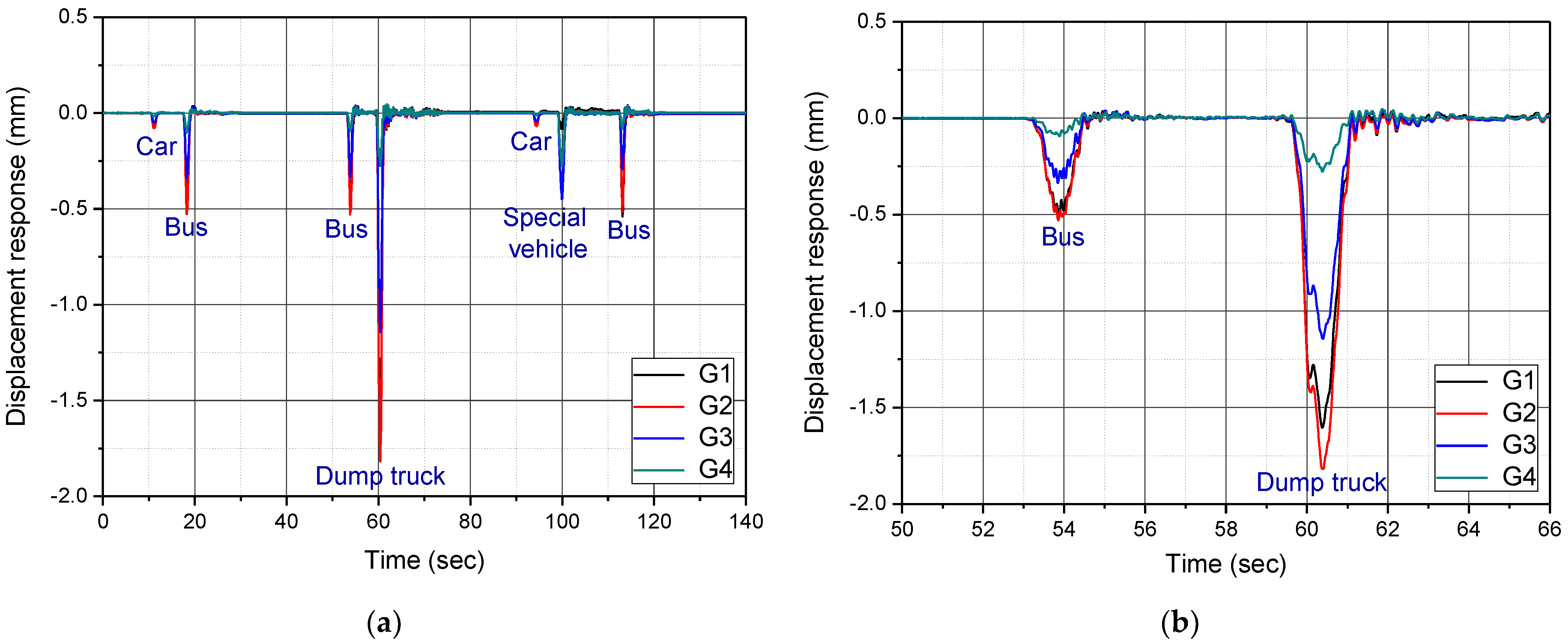
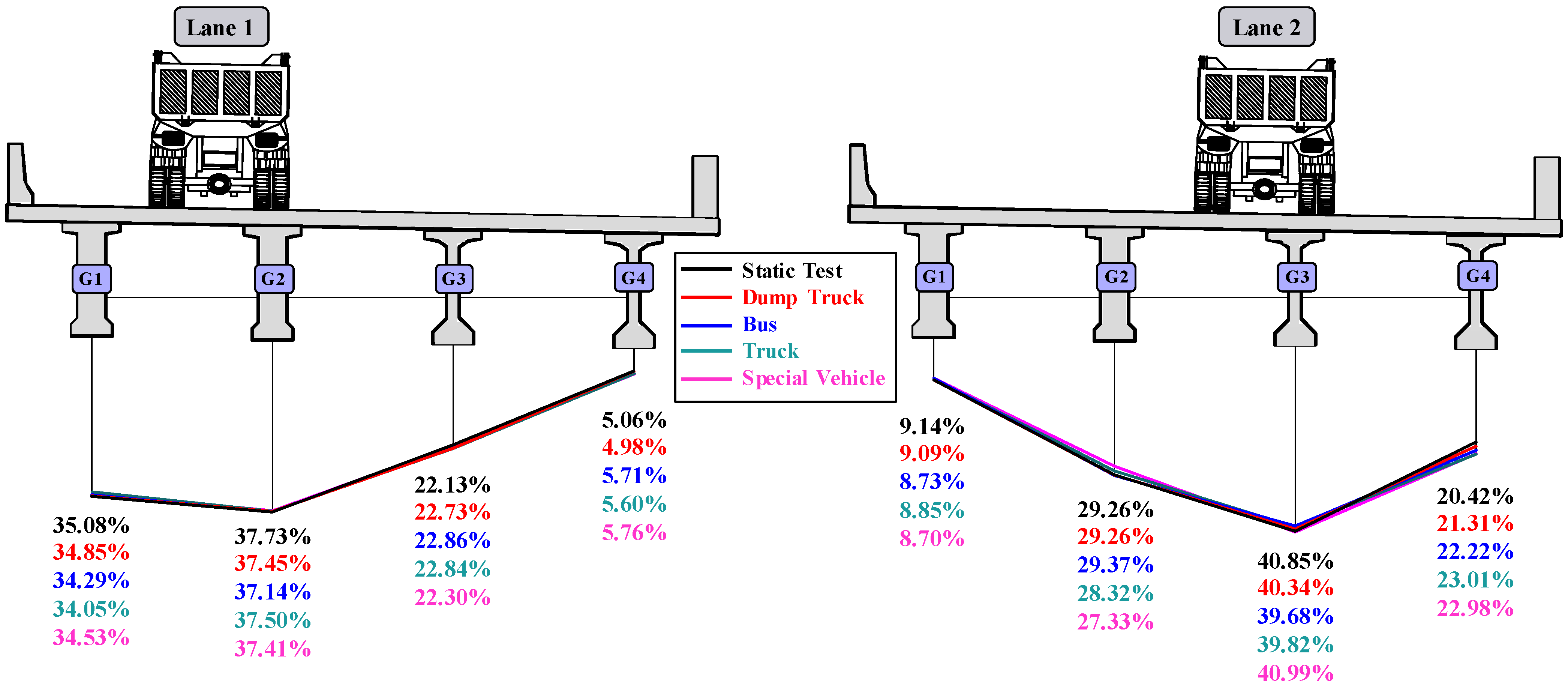

| Vehicle | Axial Load [ton] | Total [ton] | ||
|---|---|---|---|---|
| Front | Middle | Rear | ||
| 1 | 7.02 | 10.30 | 10.01 | 27.33 |
| 2 | 7.95 | 9.99 | 9.94 | 27.91 |
| LC | Lane | Vehicle | Velocity [km/h] |
|---|---|---|---|
| 1 | 1 | 1 | stop |
| 2 | 10 | ||
| 3 | 60 | ||
| 4 | 100 | ||
| 5 | 2 | 2 | stop |
| 6 | 10 | ||
| 7 | 60 | ||
| 8 | 100 | ||
| 9 | 1, 2 | 1, 2 | stop |
| 10 | 10 | ||
| 11 | 60 | ||
| 12 | 100 |
| Test | Lane | Maximum Displacement [mm] | |||
|---|---|---|---|---|---|
| G1 | G2 | G3 | G4 | ||
| static | 1 | −1.15 | −1.24 | −0.73 | −0.17 |
| 2 | −0.27 | −0.89 | −1.22 | −0.61 | |
| 1 + 2 | −1.51 | −2.16 | −2.01 | −0.82 | |
| dynamic (10 km/h) | 1 | −1.19 | −1.26 | −0.75 | −0.17 |
| 2 | −0.29 | −0.90 | −1.23 | −0.64 | |
| 1 + 2 | −1.56 | −2.16 | −1.99 | −0.79 | |
| dynamic (60 km/h) | 1 | −1.15 | −1.22 | −0.72 | −0.17 |
| 2 | −0.27 | −0.88 | −1.22 | −0.61 | |
| 1 + 2 | −1.52 | −2.12 | −1.92 | −0.78 | |
| dynamic (100 km/h) | 1 | −1.07 | −1.15 | −0.69 | −0.15 |
| 2 | −0.26 | −0.83 | −1.15 | −0.58 | |
| 1 + 2 | −1.40 | −1.99 | −1.84 | −0.77 | |
| Vehicle Type | Remarks | 1st Lane | 2nd Lane | Total |
|---|---|---|---|---|
| car | small, medium, and large vans, etc. | 70 | 17 | 87 |
| bus | large buses, etc. | 21 | 23 | 44 |
| truck | 1-, 5-, and 10-ton trucks, etc. | 21 | 29 | 50 |
| dump truck | large dump trucks, etc. | 18 | 11 | 29 |
| special vehicle | tanker trucks and trailers, etc. | 10 | 14 | 24 |
| Lane | Dump Truck | Bus | Truck | Special Vehicle | Total |
|---|---|---|---|---|---|
| 1 | 6 | 11 | 8 | 7 | 32 |
| 2 | 4 | 9 | 12 | 6 | 31 |
| total | 10 | 20 | 20 | 13 | 63 |
| Load Case | Average Maximum Displacement [mm] | ||||
|---|---|---|---|---|---|
| Lane | Vehicle Type | G1 | G2 | G3 | G4 |
| 1 | dump truck | −1.61 | −1.73 | −1.05 | −0.23 |
| bus | −0.48 | −0.52 | −0.32 | −0.08 | |
| truck | −0.79 | −0.87 | −0.53 | −0.13 | |
| special vehicle | −0.48 | −0.52 | −0.31 | −0.09 | |
| 2 | dump truck | −0.32 | −1.03 | −1.42 | −0.77 |
| bus | −0.11 | −0.37 | −0.50 | −0.28 | |
| truck | −0.20 | −0.64 | −0.90 | −0.52 | |
| special vehicle | −0.14 | −0.44 | −0.66 | −0.37 | |
Publisher’s Note: MDPI stays neutral with regard to jurisdictional claims in published maps and institutional affiliations. |
© 2021 by the authors. Licensee MDPI, Basel, Switzerland. This article is an open access article distributed under the terms and conditions of the Creative Commons Attribution (CC BY) license (https://creativecommons.org/licenses/by/4.0/).
Share and Cite
Kim, S.-W.; Yun, D.-W.; Park, D.-U.; Chang, S.-J.; Park, J.-B. Estimation of Live Load Distribution Factor for a PSC I Girder Bridge in an Ambient Vibration Test. Appl. Sci. 2021, 11, 11010. https://doi.org/10.3390/app112211010
Kim S-W, Yun D-W, Park D-U, Chang S-J, Park J-B. Estimation of Live Load Distribution Factor for a PSC I Girder Bridge in an Ambient Vibration Test. Applied Sciences. 2021; 11(22):11010. https://doi.org/10.3390/app112211010
Chicago/Turabian StyleKim, Sung-Wan, Da-Woon Yun, Dong-Uk Park, Sung-Jin Chang, and Jae-Bong Park. 2021. "Estimation of Live Load Distribution Factor for a PSC I Girder Bridge in an Ambient Vibration Test" Applied Sciences 11, no. 22: 11010. https://doi.org/10.3390/app112211010
APA StyleKim, S.-W., Yun, D.-W., Park, D.-U., Chang, S.-J., & Park, J.-B. (2021). Estimation of Live Load Distribution Factor for a PSC I Girder Bridge in an Ambient Vibration Test. Applied Sciences, 11(22), 11010. https://doi.org/10.3390/app112211010






